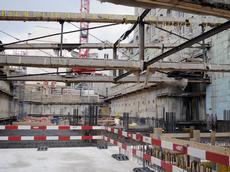A new structure for ETH Real Estate
The management of ETH Zurich’s buildings should become more streamlined and efficient: as of 1 March 2013, the university has established two different independent units and cultures that were previously under one common umbrella.

At ETH Zurich, around sixty employees handle the spatial and financial planning of ETH Zurich’s buildings, as well as the construction planning and realisation. Around 210 employees are involved in the technical building management. For these core tasks in the divisions "Building and Constructions" and "Facility Management", the Executive Board has formed two independent infrastructural areas that replace the “Real Estate” division on 1 March 2013, thereby increasing the seven previous infrastructural areas to eight.
Consideration of cultures
Real estate management involves an extremely extensive and heterogeneous set of tasks and responsibilities, says Roman Boutellier as the Vice-President of Human Resources and Infrastructure, explaining the reorganisation. “The core duties of the divisions Building and Constructions on one hand and Facility Management on the other are interlinked and they need to cooperate closely. Nonetheless, we are talking about two very different cultures within ETH Zurich,” states Boutellier. “Consequently, we wanted to separate these two core areas and the corresponding tasks from an organisational perspective.”
Moreover, according to Boutellier, the infrastructural area of Real Estate has grown very big in recent years. By dividing it into two independent units, the Executive Board promises a streamlining of processes and an increase in efficiency. The restructuring does not mean any job cutbacks. According to its president, André Blanchard, ETH Zurich’s Personnel Committee “can thus declare itself in favour of the measure”.
New structure: state of the art
Comparable public institutions such as the canton and the city of Zurich structure their building divisions in a similar way, says the Vice-President of ETH Zurich. Apart from anything else, the term “ETH-Zurich real estate” has also been known to cause misunderstandings: “ETH Zurich constructs and manages its real estate and, as a government institution, does not run a commercially oriented real estate company,” explains Boutellier. Dropping the term in the new structural names should avoid this ambiguity.
Markus Meier Joos leaves ETH Zurich
Real estate support (including financial planning, controlling, procurement and information technology), and construction and portfolio management form the new infrastructure area Building and Constructions. This has an investment volume of nearly 200 million francs a year to manage in the next few years. In light of the significance of the field, a director is to be appointed to run the division; the wheels have already been set in motion. The new Facility Management division, which guarantees the energy supply and service quality in all ETH-Zurich buildings and rooms, remains under the management of the previous head of department, Walter Iten.
In the course of this reorganisation and due to different views on the strategic orientation, the previous director of the Real Estate division, Markus Meier Joos, has decided to leave ETH Zurich.







READER COMMENTS